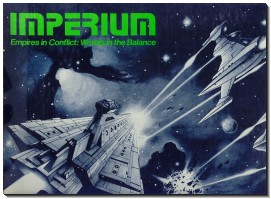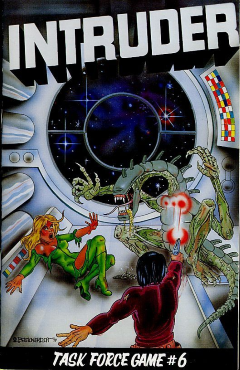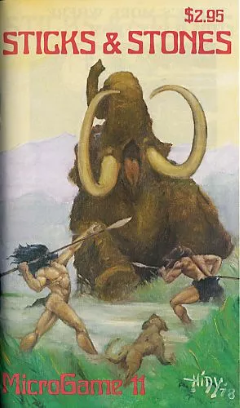
Space Empires is a science fiction board game published by Mayfair Games in 1981.

Space Empires is a science fiction board game published by Mayfair Games in 1981.
Space Empires is a science fiction game of conquest for 2–6 players. [1] Twelve alien races, identified by a letter of the alphabet from A to L, vie for control of a star sector. The basic game includes rules for combat and movement, as well as rules for the production of ships. The advanced game gives each race one unique ability. [2] For example, Race A can use a paralyzing ray to capture ships and add them to their own fleet. [1]
Space Empires, a microgame packaged in a ziplock bag, has the following components: [3]
Each player randomly draws two of the races, and places their ships on their home worlds. Any alien races not chosen become neutral parties, and their ships are stacked on their home worlds. [1]
Each turn consists of three phases: [1]
If, at the end of a turn, one player controls seven or more systems, the other players have one turn to reduce this number to six or less. If they are successful, the game continues. If they are not, the player who still has control of at least seven systems is the winner. [1]
Alternatively, the players can set a limit of either time or number of turns. The player who controls the most systems at the end of the game is the winner.
Mayfair Games was founded in 1981 to publish the board game Empire Builder . [4] One of their next products was 1981's Space Empires, a microgame designed by Neil Zimmerer, with cover art by Lois Griffin. [3] An expansion set was mentioned in the Space Empires rulebook, [2] but was never published.
In Issue 47 of The Space Gamer , William A. Barton thought the game was perhaps a bit too simple, saying, ""Overall, Space Empires is an interesting, enjoyable game if you like easy-to-play 'quickies' with a twist. If you prefer a lot of complications, you might want to pass this one up – or perhaps wait for the expansion set mentioned at the end." [2]
Steffan O'Sullivan thought the random draw of aliens at the start of the game gave it a high replayability factor, but disliked the fact that "some players will be out of the game early, while the game can continue a long time thereafter." Nevertheless, he recommended the game, saying, "Pick one up if you like the idea of multi-player science fiction wargames - this is a good one." [1]
In Issue 27 of Simulacrum, Brian Train noted, "If you can get past the idea of starships having Zones of Control and the simple AR/DR/EX Combat Results Table, you will have fun with this." [5]
David Lent and Len Krol of Centurion's Review found the game easy to learn, calling it "a space version of Risk ". They felt the two-player game was unbalanced, with favor going to the player with the better initial draw of races, and thought the game would be more balanced with 3–4 players. They questioned the use of zones of control, where ships passing within one hex of another ship had to stop and engage in combat. Although this is standard in land-based wargames, Lent and Krol found its use "bizarre in an outer space-based game." [6]

G.E.V. is a science fiction board wargame that simulates combat in the near future between armored hovercraft, supertanks and other futuristic weaponry.

Imperium is a science fiction board wargame designed by Marc W. Miller, and published in 1977 by the Conflict Game Company and Game Designers' Workshop (GDW). It features asymmetrical forces, each of the two sides having its unique set of constraints. The game came in a cardboard box illustrated with a space battle on the exterior. It included a cardboard-mounted, folding map of a local region of the Milky Way galaxy, a set of rules and charts, and the 352 counters representing the various spacecraft, ground units, and markers, and a six-sided die. A second edition was published in 1990, a third in 2001, and the first edition republished in 2004.

Revolt On Antares is a science fiction themed microgame designed by Tom Moldvay and produced by TSR, Inc. in 1981. Similar to the microgames produced by Steve Jackson Games, it was sold in a transparent plastic shell case and came with rulebook, full-color hex-map, counters, and one six-sided die. Other games in this series include They've Invaded Pleasantville!, Remember the Alamo, Attack Force, Vampyre, Viking Gods, Icebergs and Saga.

Chitin: I is a science fiction microgame published by Metagaming Concepts in 1977 in which bands of intelligent insects vie for resources.

Alpha Omega is a science fiction board wargame published by Battleline Publications in 1977 that simulates combat between alien and human space fleets. Avalon Hill acquired the game and republished it in 1980.

StarGate is a science fiction board game published by Simulations Publications, Inc. (SPI) in 1979 in which players wage combat via spaceships.

Intruder is a solitaire science fiction microgame published in 1980 by Task Force Games in which a rapidly maturing alien roams a space station, ambushing and killing crew members.

Cerberus is a science fiction board wargame published by Task Force Games in 1979.

Robots! is a microgame published by Task Force Games in 1980 in which players fight each other using combat robots.

Spellbinder is a fantasy microgame published by Task Force Games in 1980 in which wizards compete to conquer the central castle.

Holy War is a science fiction board wargame published by Metagaming Concepts in 1979 in which two groups battle each other inside a pocket universe.

Invasion of the Air-eaters is a science fiction near-future board wargame published by Metagaming Concepts in 1979 in which aliens invaders attempt to replace the oxygen in Earth's atmosphere with sulfur dioxide.

Ram Speed, subtitled "Naval Warfare in the Bronze Age", is a two-player microgame published by Metagaming Concepts in 1980 that simulates naval combat between galleys in the Mediterranean during the Bronze Age when the preferred method of attack was ramming a ship.

Dimension Demons is a science fiction board wargame published by Metagaming Concepts in 1981 as part of its MicroGame line.

Transylvania is a microgame published by Mayfair Games in 1981 that simulates a battle between Transylvanian villagers and the evil forces that surround them.

Moon Base Clavius is a science fiction board wargame published by Task Force Games in 1981.

City States of Arklyrell is a fantasy board wargame for 2–4 players published by Task Force Games in 1983, a microgame in which players fight for control of the most Citadels.

Last Frontier: The Vesuvius Incident is a science fiction solitaire board wargame published by Fat Messiah Games in 1993

Arcola, The Battle for Italy 1796 is a board wargame published by Operational Studies Group (OSG) in 1979 and republished by Avalon Hill in 1983 that is a simulation of the Battle of Arcola between French and Austrian forces in 1796. The game was designed to tempt players to purchase OSG's previously published and larger wargame Napoleon in Italy.

Sticks & Stones is a board wargame published by Metagaming Concepts in 1978 that is set in the Neolithic Age.